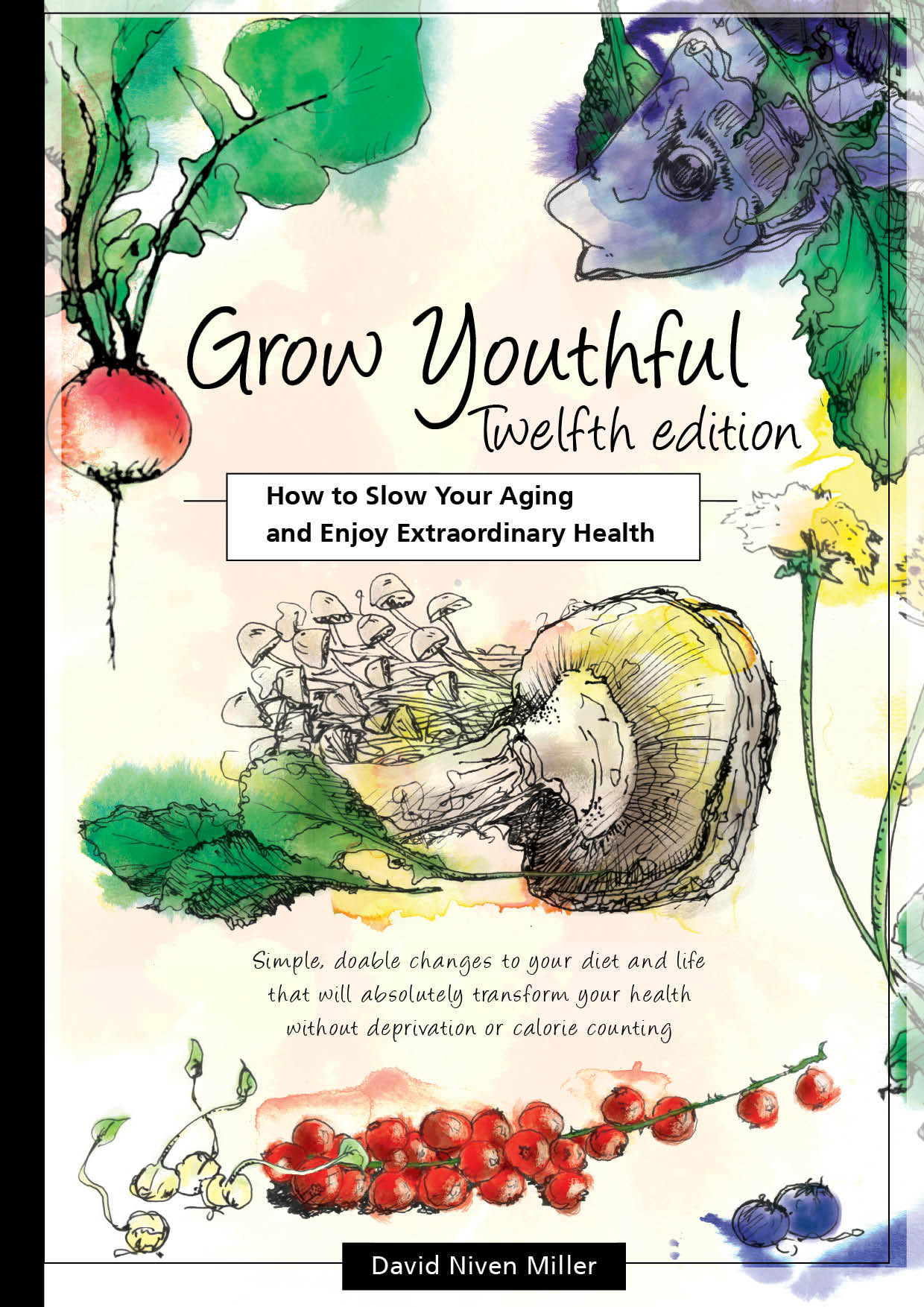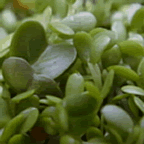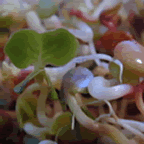
SPROUTING
Why sprout?
What you can sprout
How to sprout
Using sprouts
Why sprout?
Many people find they cannot tolerate grains, seeds, nuts and legumes, or products such as breads, cakes or bean dishes made from them. Do you suffer from indigestion, flatulence, heaviness and other maladies after eating them?
Grains/seeds and legumes/beans contain enzyme inhibitors, which keep them dormant until they are soaked and start to sprout. They also contain phytic acid (an organic acid in which phosphorous is bound) in the outer layer or bran, and a variety of toxins to protect them from being eaten by mammals, including humans. These enzyme inhibitors, phytic acid and other toxins make dry grains, seeds and legumes indigestible. Phytic acid also reacts with many essential minerals, such as calcium, magnesium, copper, iron and especially zinc, and stops their absorption in your intestines.


Early humans did not evolve with grains or legumes as part of their diet. It is only in the last 10,000 years since the advent of agriculture, that humans have started to eat them. I emphasise in Grow Youthful that grains and legumes are a new food and that the human body has not fully adapted to digesting them. No other primates eat them.
Soaking neutralises the enzyme inhibitors present in dry grains, seeds and legumes, and starts the production of numerous beneficial enzymes. As they soak, the enzymes, Lactobacilli and other helpful organisms break down and neutralise the phytic acid. As little as seven hours soaking in water removes most of the phytic acid. Soaking, fermenting and sprouting also breaks down gluten and other difficult-to-digest proteins into simpler components that are more easily absorbed. However, not all toxins are removed, with wheat and some legumes (see below) being the worst affected.
A diet with grains or legumes that have not been sprouted or soaked can lead to serious mineral deficiencies, bone loss, and digestive problems such as reflux, bloating, food allergies, irritable bowel and other forms of weak digestion.
Breads and other products made from flour that has not been risen or soaked for at least seven hours have a similar effect. Most commercial breads, pastries, biscuits etc are made from un-soaked flour.
Commercially baked bread made from milled dry grains and fast acting yeast is prepared and baked in less than a few hours. No Lactobacilli are involved, only one strain of yeast is used, and the conditions are not suitable for neutralising enzyme inhibitors and phytic acid. These breads are hard to digest.
Sprouts. The toxins in many legumes do not appear in their sprouts. Sprouts are a living, enzyme-rich food, natural and low in calories. Their vitamin A content will usually double, various B group vitamins will be 5 - 10 times higher, and vitamin C will increase by a similar order. Their protein content becomes easily digestible, and rich new nutrients such as enzymes and phytochemicals are created. They contain significant amounts of bio-available calcium, iron and zinc.
When a dormant seed sprouts, its starch is converted into simple sugars, and long chain proteins are split into smaller, easily-digestible molecules. Sprouted beans and seeds are like a pre-digested food.
What you can sprout
Most seeds sprout easily, as do many legumes. Nuts are more difficult to sprout.
Fresh, alive seeds in good condition sprout the best. If a seed will not sprout, this is an indication that it is "dead" and the enzymes in it have been destroyed. It may be old, rancid, cooked, irradiated, sprayed or physically broken or damaged.
My best sprouting results have been with garbanzo beans (chickpeas), wheat and rye berries, sunflower seeds and mung beans. This may be a reflection of the local conditions and suppliers.
You should treat raw legumes with caution. Chickpeas (also known as Garbanzo beans) are the most digestible of the beans. When sprouted with 1-2 cm tails, most of their enzyme inhibitors are inactivated. This is why they are the most widely used raw bean in several traditional cuisines, particularly around the Mediterranean as a base for humus. However, I personally would never eat raw beans (raw sprouts are OK).
Mung beans make an excellent sprout, used widely in Chinese cooking. However, they primarily use the sprouts and not the beans, and the sprouts are often stir-fried.
Soy and kidney bean sprouts are toxic and should be avoided. Sprouted lentils, black eyed beans, partridge peas, peanuts and vetch retain phytates which cause poor digestion and gas.
Alfalfa sprouts are mildly toxic - do not eat them every day, and avoid them if you are a cancer patient, have a weak immune system or suffer from inflammation.
Broccoli sprouts on the other hand, contain some potent anti-cancer compounds, and are recommended for cancer patients, as well as being a cancer preventative. Broccoli sprouts contain several compounds that promote autophagy, prevent metastasis, and provide a great food for prevention of, and during recovery from cancer. The most important compound is sulforaphane, and broccoli sprouts are the richest known source. You can grow broccoli sprouts yourself, kits with seeds and instructions are readily available, and broccoli sprouts are available in many shops
Most raw sprouts contain hemagglutinins, which inhibit the absorption of proteins and fats. The worst are soybeans and kidney beans, followed by Pinto, Navy, Black eye, Lima, Black beans, Aduki (Adzuki) beans, lentils and peas. Hemagglutinins are destroyed by cooking.
Some people are more sensitive to raw sprouted legumes, and need to cook them. This is no reason to avoid the nutritious and enzyme-rich sprouts of other seeds.
If you are going to leave the sprout longer and let it grow a little into a microgreen, you will need to plant the sprouts in a growing medium such as a soil or potting mix. It is best to sprout in rich soil rather than in a hydroponic medium. Rich soils contain a rich soil biome, whereas hydroponic growth media can be almost sterile. A rich mix of microorganisms promotes a variety of phytonutrients such as sulforaphane.
How to sprout
First, pick through and discard any broken, mouldy, discoloured or disfigured seeds. In particular, try to remove black, dark brown or green coloured mouldy seeds. They can contain harmful toxins that you would want to avoid, whether you are sprouting or cooking them.
Next,soak them. To sprout a grain, seed or bean, first wash them and then soak them in cool to tepid, filtered or spring water. Soaking time varies between 4 and 12 hours, depending on the size and hardness of the seed. Large hard beans such as garbanzo beans need 12 hours, whereas small soft seeds like buckwheat, amaranth, quinoa and many vegetable seeds only need 4 hours. Rinse them and change the water every couple of hours while they soak.
An alternative method of sprouting without soaking is to keep the seeds/beans damp for a longer period. They still need rinsing 2-3 times per day.
Successful sprouting depends on a number of factors including:
- The freshness of the seeds and how "alive" they are. Many seeds, especially if they have been imported, have been irradiated. Others are just old.
- Whether the seeds are broken, discoloured or chemically treated.
- The water's pH, mineral and salt content. Sprouting is encouraged in slightly salty and acid water, so you can add a pinch of sea salt and a spoon of vinegar.
- The water's temperature. Cold climate grains such as oats can even be sprouted in your refrigerator.
Keep them damp. After the initial soaking, keep the seeds damp. I put them in a large sieve, and rinse them under the tap a couple of times a day. You can also put them in a jar, with a piece of material over the top, tied on with a string or rubber band. The seeds need to be kept damp and aired, but not wet, otherwise there is a chance of mould or spoiling.
Some seeds start to sprout in a few hours. Using top quality sunflower seeds in the summer, I have had sprouts starting in 8 hours. At the other extreme, large cannelloni beans can take two or more days to begin sprouting. Within 2-5 days most of the bigger seeds, nuts and beans are ready. They are ready when the root (not the shoot, which is longer) is the length of the seed.
Keep your sprouting seeds and grains out of full sunlight. Natural light is OK, but full sunlight will encourage leafing.
Using sprouts
Try keeping two containers of sprouts in your fridge, especially in the summer. Sprouts are the base for all sorts of delectable pates and raw food recipes, and provide a colourful and living addition to any dish - particularly salads.
Use a variety of different sprouts such as alfalfa, garbanzo beans (chickpeas), lentils, mung beans, peas and sunflowers. Keep changing which beans you use, so that your body is not exposed to using the same sprout for days or weeks at a time.
Keep a written note on which you find digest the best, or which have any side-effects. Try lightly cooking the less-digestible raw sprouts in stir-fry's; the light cooking makes them much more digestible.
